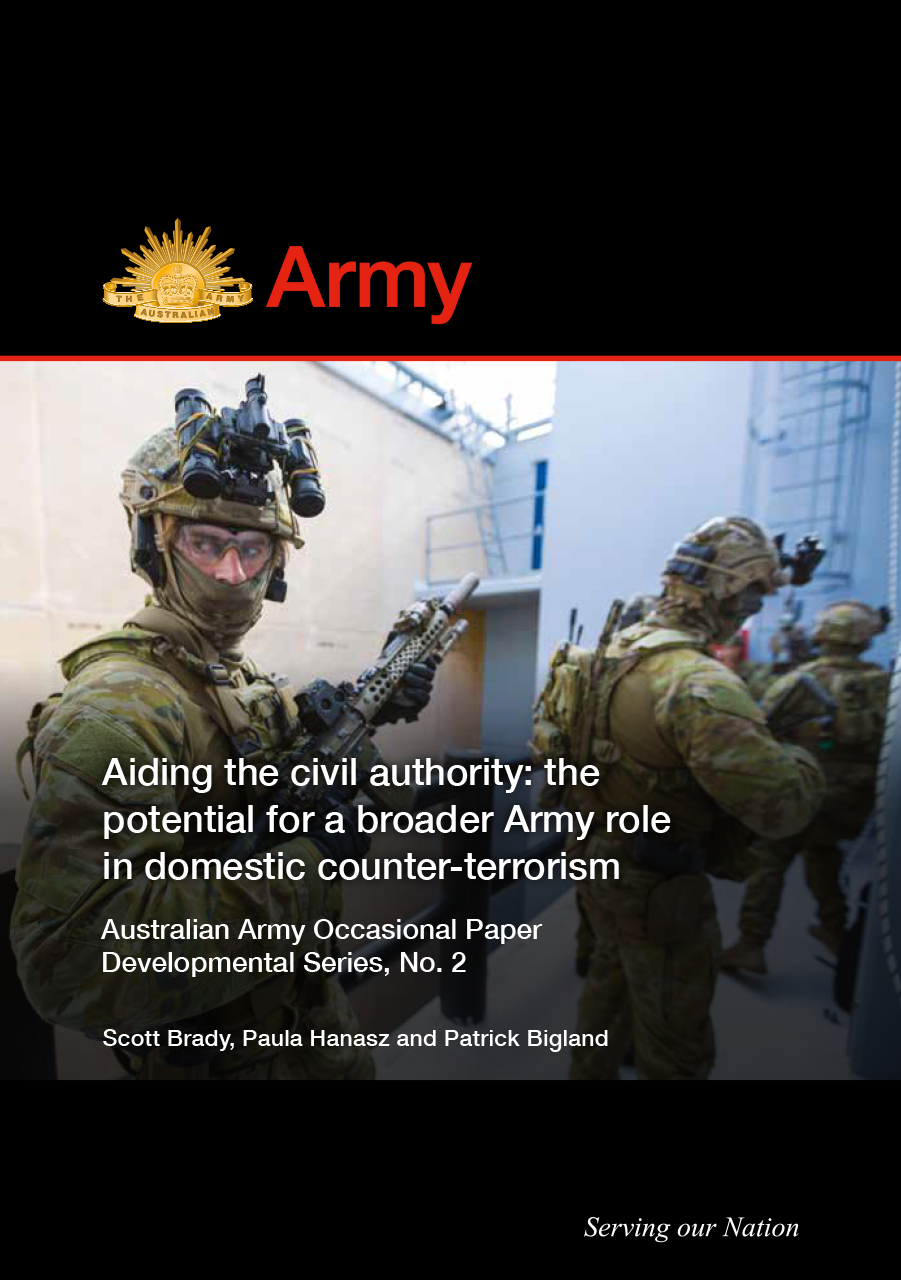Aiding the Civil Authority
The Potential for a Broader Army Role in Domestic Counter-Terrorism
Terrorist incidents in recent years—including the 2014 Sydney Lindt Café siege, the November 2015 Paris attacks and the 2016 Nice Bastille Day attack—have continued to highlight the vulnerabilities of Western societies to extremist violence. They also demonstrate how some global developments have removed some impediments for groups or individuals to conduct high-profile attacks with local resources and without deep connections to a terrorist organisation. In the wake of recent events, there has been speculation in Australian media about whether the Defence Force should play a bigger role in protecting the Australian public from terrorist incidents.
The Australian Government has indicated an increasing willingness to use Defence for domestic counter-terrorism (CT). In the Defence White Paper 2016, the government’s direction for Defence to support domestic CT was more prominent than in previous iterations. More explicitly, in July 2017, then Prime Minister Malcolm Turnbull announced, ‘The Australian Defence Force will expand its role in assisting the states to respond to terrorist incidents’. As a part of that initiative, the Government introduced a Bill in June 2018 to amend the Defence Act 1903. The changes proposed in the Defence Amendment (Call Out of the Australian Defence Force) Bill 2018 are aimed at strengthening the support that Defence can provide in response to major acts of ‘domestic violence’.
The use of Defence capabilities certainly indicates a government’s level of resolve in dealing with a terrorist incident. Defence forces are generally understood to bring additional capabilities and capacity that can reinforce a civil authority. However, it is important to clarify what this means in a practical sense. The aim should be to ensure that all parties—government, Defence, first responders etc.—have a consistent expectation of what Defence can actually do in a CT scenario.
This paper examines what a bigger role for Army in domestic CT response could actually look like. Given the current threat environment, what might a terrorist incident requiring an Army response look like? What types of activities may Army need to perform to assist Australian governments to deter/prevent, respond to or recover from a terrorist attack? Furthermore, what could be some of the implications—for policy, for readiness or for government/public expectations—of this wider role?
The research provides Army with a basis for assessing how its capabilities and preparedness for supporting civil authorities in domestic CT align with government expectations, given the current level of terrorism threat awareness. It provides analysis to support Army’s provision of advice to government on how, and the extent to which, Army can make a greater contribution to domestic CT. Finally, this research aims to inform Army decisions regarding capability and preparedness to support domestic CT.
This paper provides an examination of terrorism incidents in comparable nations, using both quantitative and qualitative views. A quantitative survey was designed with the aim of improving understanding of the relative prevalence and consequences of different forms of terrorist attacks. The qualitative view looked at case studies to examine the details of how these attacks occurred and what security actions were conducted during preparation, response and recovery. The analysis focuses on applying the findings to Australian circumstances.
The scope of domestic CT for this research is incident focused. It only considers Army’s potential operational roles in the context of a terrorist attack on Australian soil. This scope excludes Army’s role in international CT or incidents in the maritime or aviation domains. An examination of support to CT intelligence or investigations was not possible in open-source research.
This paper is based on open-source, desk-based research conducted throughout 2018. The research consisted of three components.
The first component was a literature review. This surveyed previous material on issues relevant to how nations use security forces for CT incidents domestically. The literature review also examined Australian national, Commonwealth, state and territory legislation, policies and other publicly released documents.
The second component was a quantitative analysis of terrorism incidents in comparable nations in recent decades. The principal source for this component was the Global Terrorism Database (GTD), as produced by the University of Maryland’s National Consortium for the Study of Terrorism and Responses to Terrorism (START). This analysis initially considered all incidents recorded in Organisation for Economic Co-operation and Development (OECD) countries during 2001–2017.
The final component was the examination of six case studies derived from the GTD analysis. These were selected to represent different types of incidents that may have relevance for Australia. The focus for the case studies was to investigate the role played by security forces before, during and after each incident. Where available, official government reports on each incident were used as the main reference. In all case studies, the researchers also referenced media reporting and think-tank publications.
| Attachment | Size |
|---|---|
| Aiding the Civil Authority - Brady-Hanasz-Bigland (2.69 MB) | 2.69 MB |

Publication Date
Publication Identifiers
ISSN: 123456789-0
ISBN: 987654321-0



